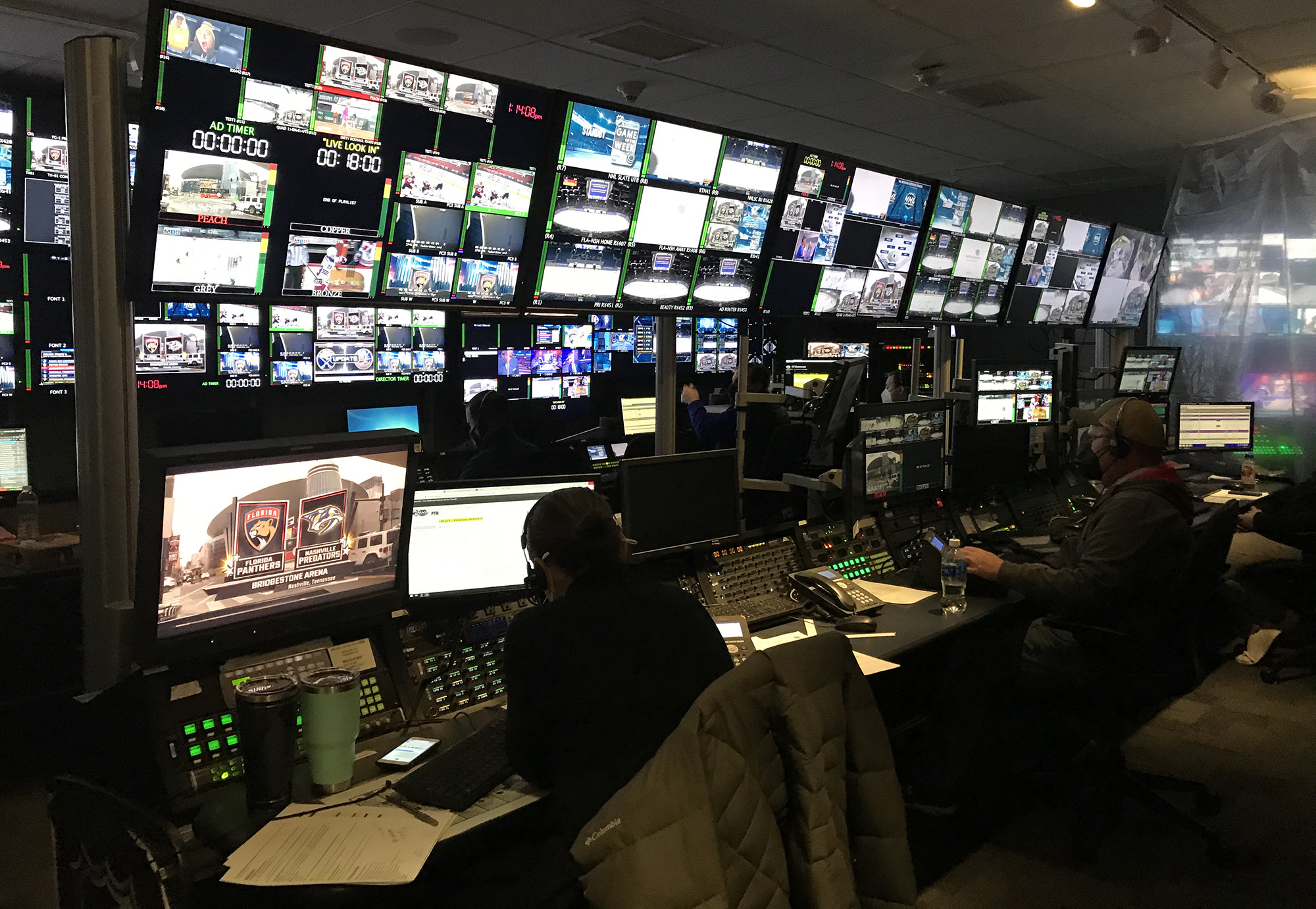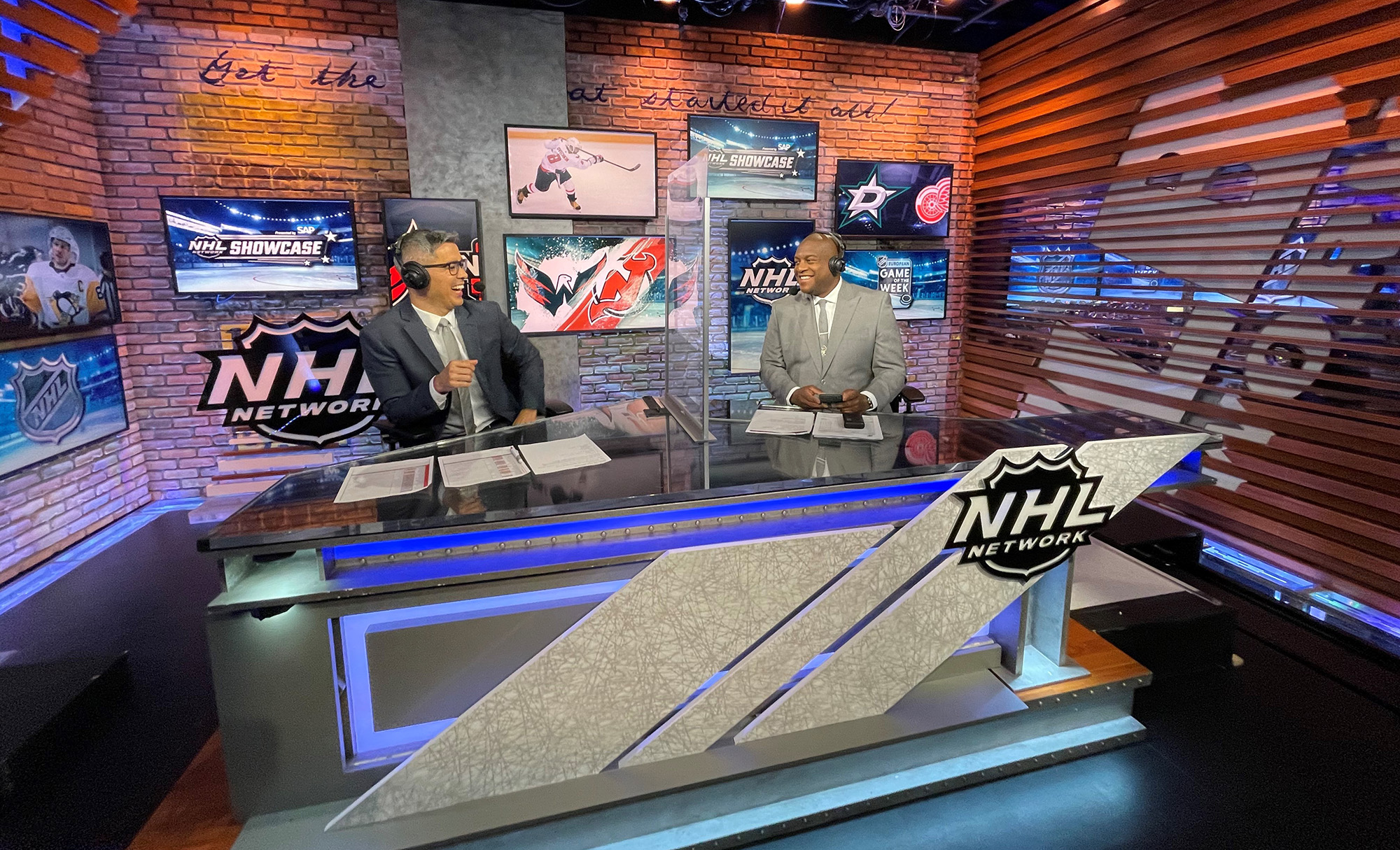NHL Network Showcase Marks New Chapter in Live Game Production for League’s Cable Net
16-game package deploys the network’s own talent and production facilities
Story Highlights
Last month, NHL Network took a massive step forward in its evolution, launching its first live production of a regular-season game using its own on-air talent and production facilities. Branded NHL Network Showcase domestically and the NHL European Game of the Week internationally, the 16-game slate uses a clean feed from the home team’s RSN, with broadcasts produced at the NHL Network/MLB Network studios in Secaucus, NJ, and featuring NHL Network graphics, branding, commentators, and pre/postgame and intermission shows.
“The conversation has been ongoing for years about whether and when NHL Network should [produce] games,” explains Eric Eisenberg, VP, programming and operations, NHL Network. “Coming into this season, we felt we had hit the point where it was the appropriate time. We also were able to work with the league to build out a schedule that made sense and showcased a lot of teams that wouldn’t typically be featured on national broadcasts. As we continue to find different ways to engage fans and build different properties, this year felt like the right time to start looking at our own live games.”
While production of live regular-season games is nothing new for NHL Network, which has carried games since it launched in 2008, this marks the first time the network is delivering its own branded broadcast rather than just airing the local RSN’s feed. This weekend, the NHL Network Showcase hits a high point with a double-header featuring New York Rangers–Boston Bruins on Saturday at 1 p.m. ET and Arizona Coyotes–Minnesota Wild on Sunday at 2 p.m.
Live From Secaucus: Inside the Production Workflow
To produce each broadcast, NHL Network is taking in a clean program feed from the home team’s RSN and using it as the basis of the presentation. In Secaucus, a dedicated production crew integrates NHL Network graphics, animations, scorebug, and branding, as well as commercial insertion. The workflow is similar to the MLB Network Showcase games produced in Secaucus during last year’s pandemic-stricken season; the NHL games, however, do not include two ancillary cameras for the network to use at its discretion.

A dedicated crew leverages a clean feed from local RSNs to produce NHL Network Showcase games from a control room at the network’s Secaucus, NJ, broadcast center.
“This is the first step off for us,” notes Jacob Soto, VP, engineering and IT, MLB Network/NHL Network. “Because of everything that is happening in the world with the pandemic, we’re starting out by taking the RSN feed, and then we will grow into it. It just doesn’t make sense right now to do all the games we have on the slate for this year as full [onsite] productions. Plus, we had a lot of lessons learned last year [from the enhanced world-feed MLB productions], and we were able to invest that into the NHL Network Showcase.”
Play-by-play announcer Stephen Nelson and a rotating team of analysts call the action off-monitor from Studio K, and the pre/postgame and intermission shows are produced at The Rink, NHL Network’s primary studio in Secaucus. The monitor from which Nelson and his analyst call the action displays the program feed, and the production team works closely with the RSN crew to ensure that talent is aware of upcoming replays and segments before they’re played out.
“The RSNs have been great,” says Chris Pfeiffer, senior coordinating producer, remote events, MLB Network/NHL Network. “The communication has been solid on game day, [with their] helping us by tipping us off on replay packages and rollouts — anything that [we can] pass on to our announcers so they’re not surprised. If we’re all doing our job the right way, the viewers at home won’t notice the difference. We believe we’ve done that, so it has been a solid first few weeks.”
Across the Pond: Launching the NHL European Game of the Week
In addition to the domestic broadcast, NHL Network provides a separate feed for the NHL European Game of the Week. Secaucus is using a split-feed model: whenever a branded graphic or element is integrated into the show, each feed automatically receives either the Network Showcase or the European Game of the Week version. In addition, NHL Network is producing several international-specific elements, including a show open that is completely independent of the NHL Network Showcase open and focuses on international players.
“That split feed was a little bit of a test for us leading up to that first weekend,” notes Pfeiffer. “But it has gone very smooth the last few weeks. [It allows us to] focus specifically on international players and makes [the European broadcast] more specific to that audience.”
Building on World Juniors and the Evolution of NHL Network
Production of the slate of Showcase games follows NHL Network’s exclusive coverage of the 2021 IIHF World Junior Championship, in which Team USA win the Gold Medal over Canada in a championship game that garnered plenty of attention. For it, NHL Network used a workflow similar to that used for Showcase games to produce every Team USA game, with Nelson handling play-by-play from Secaucus.
“The World Juniors has been a massive undertaking for us for years and has continued to grow,” says Eisenberg. “This year, with the lack of NHL hockey during the pandemic, it received even more focus and had an even bigger impact. We felt really good and comfortable about the team and the setup that we had to support it. I think this year’s Juniors really did solidify things and gave us confidence that we had all the pieces put together to do these [NHL Network Showcase] broadcasts.”
In addition to the 16 Showcase games and World Juniors, Phase 2 of the 2020 NHL Draft Lottery (awarding the first overall selection) was conducted at NHL Network’s Secaucus studio in one of the network’s largest and highest-profile in-studio productions to date.
“At this point, we truly think can do anything that’s asked of us out of [the Secaucus facility],” says Soto. “Is it easy? Not all the time. But everybody works hard to make sure we put the best product out there. The only thing that limits us is if we run out of studio space. But, in terms of our personnel and technology, we think we are capable of almost anything using this facility.”
The Art of Calling Hockey Off-Tube
Nelson serves as the face of the NHL Network Showcase, calling all 16 games alongside a rotating stable of network analysts: Brian Lawton, Dave Reid, Mike Rupp, and Kevin Weekes. Although much of the key action in hockey occurs off-camera, Nelson and company are tasked with calling the game from Secaucus based solely on the program feed from the RSN.

Stephen Nelson (left) and Kevin Weekes call the NHL Network Showcase game remotely from Studio K in Secaucus, NJ.
“We see the same images as the viewers,” says Nelson. “When I say on the broadcast, ‘we are just watching a hockey game together with [people at home],’ I mean it. Our monitors have only the program feed, no wide-angle shots to see line changes or action away from the puck. We are just following the RSN’s main center-ice cam during the flow of play.”
A veteran of calling events off-tube from the studio, he opines that successful remote commentary is all about communication.
“Constant communication is key,” he explains. “The producer in the chair is always talking to us and telling us what they’re doing in the [RSN] truck – they’re coming back with replays after a penalty or a big hit, or they’re going to bring up a graphic — so that we can follow the storyline and transition as best as possible. One thing I’m proud of is that we never get a sense of that stress or chaos, because of how they’ve been communicating and relaying things to us. It hasn’t been anything super technological or revelatory; it just all comes down to communication.”
NHL Network has looked to differentiate its broadcasts from other networks’ in a variety of ways but, most significantly, by focusing on social media and interacting with fans during the game. Nelson, a veteran of Bleacher Report prior to joining MLB Network/NHL Network, regularly references social-media posts throughout the broadcast.
“The overall tone we’re going for is that we’re just watching hockey games together and having fun with everyone watching. We’re not taking ourselves too seriously,” he says. “I have social media open during the game and I try to shout out as many questions and [reference] as many fans as possible. We want those watching us to engage with us and feel like they’re a part of this. Fans are smarter than ever today, and they don’t want to be talked at anymore; they want to have a conversation.”
